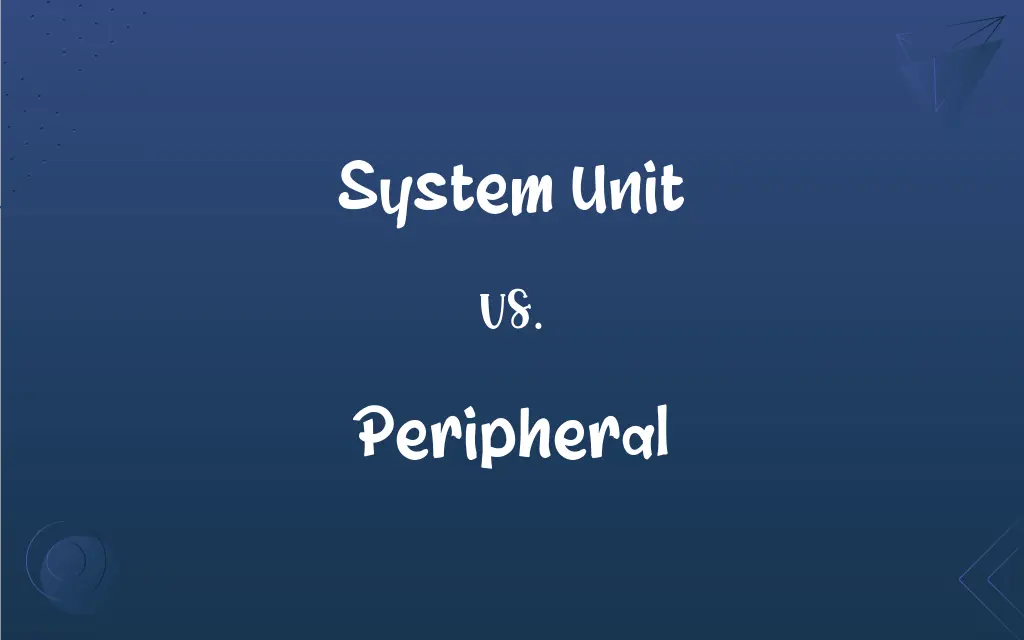System Unit vs. Peripheral: What's the Difference?
Edited by Aimie Carlson || By Harlon Moss || Updated on October 6, 2023
System unit is the core computer housing critical components like the CPU and memory, while a peripheral is an external device, like a printer or keyboard, connected to the computer to add functionality.

Key Differences
In examining technology, the term "system unit" carries a distinct meaning. System unit generally refers to the main body or the case of the computer which houses the primary components essential for processing and storage, such as the CPU, RAM, and hard drive. On the other hand, "peripheral" denotes devices that are external to the system unit. Peripherals are auxiliary in nature, providing additional functionality and often enabling varied interactions with the computer, such as input and output operations.
Looking at the system unit further, it stands as the heartbeat of a computer system. Not only does the system unit contain the central processing unit (CPU), but it also houses other vital components like the motherboard and power supply, making it pivotal for the system’s operation. In contrast, peripherals like keyboards, mice, and printers provide means for users to interact with the computer, yet they do not engage in actual data processing, which is a critical distinction from the system unit.
The system unit is considered indispensable for the operation of the computer. Without it, the computer lacks the fundamental components needed for processing information and executing commands. Conversely, peripherals, though they might enhance usability, are not crucial for the basic functioning of the computer. The computer can operate without peripherals, though its utility may be drastically limited in terms of user interaction and functionality.
Understanding that the system unit houses vital hardware like the CPU, hard drives, and memory cards is paramount. It serves as the nucleus of the computer system, facilitating all major computational activities and data storage. In stark contrast, peripherals like monitors or speakers, facilitate user engagement and provide additional functionalities but are not involved in actual computational processes, differentiating them fundamentally from the system unit.
By delving into their functionalities, the system unit’s role as the primary processing hub becomes clear, processing data and executing software. Meanwhile, peripherals often act as conduits for user interaction, enabling tasks like data input through a keyboard or data output through a printer, demonstrating a supportive, rather than a central, role in data processing and management.
ADVERTISEMENT
Comparison Chart
Function
Processes data and runs software.
Provides additional functionality like input/output.
Necessity
Essential for computer operation.
Not essential, but enhances usability.
Components
Includes CPU, motherboard, and storage devices.
External devices like keyboards, mice, and printers.
Location
Typically the central, housed component of a computer.
External to the system unit, often connected via ports.
User Interaction
Not directly interacted with by users.
Facilitates direct user interaction with the computer.
ADVERTISEMENT
System Unit and Peripheral Definitions
System Unit
The system unit houses vital components like the motherboard, memory modules, and data storage devices.
When the system unit malfunctioned, all the primary computing functions were disrupted.
Peripheral
Peripherals serve as accessories that can provide additional input, output, and storage capabilities to a computer.
I bought a new peripheral, a webcam, to improve my video conferencing quality.
System Unit
The system unit serves as the primary hub for data processing and storage in a computer system.
Technicians often open the system unit to upgrade hardware components like RAM or SSDs.
Peripheral
Peripherals can either be essential for specific interactions, like a monitor for display, or optional, like a printer.
While the keyboard is a peripheral necessary for typing, a joystick might be optional unless gaming.
System Unit
A system unit encompasses the physical case that protects and holds various internal computer components.
The compact design of the system unit allows it to fit neatly within limited desk spaces.
Peripheral
Peripherals allow users to interact with computers, offering varied methods for input, output, or data storage.
Using a scanner, a kind of peripheral, I converted my physical photos into digital format.
System Unit
The system unit is the main part of a computer that contains the central processing unit.
The system unit of my computer is equipped with the latest processor to enhance performance.
Peripheral
A peripheral is an external device that enhances and extends the functionality of a computer.
The printer, a common peripheral, allows users to produce physical documents from digital files.
System Unit
The system unit includes power supply units ensuring other internal components receive the necessary electrical power.
If the fan inside the system unit becomes too noisy, it might indicate a power supply issue.
Peripheral
A peripheral can be connected to the computer wirelessly or through various port types like USB or HDMI.
The mouse, a typical peripheral, can be connected either using a USB cable or Bluetooth.
Peripheral
Related to, located in, or constituting an outer boundary or periphery.
Peripheral
Perceived or perceiving near the outer edges of the retina
Peripheral vision.
Peripheral
Of the surface or outer part of a body or organ; external.
FAQs
What is an example of a peripheral?
Examples of peripherals include keyboards, mice, printers, and scanners.
What is a system unit?
A system unit is the central part of a computer, housing the CPU, motherboard, and other vital components.
Are peripherals necessary for a computer to function?
Peripherals are not essential for basic computer functioning but are crucial for user interaction and additional functionalities.
Can a computer function without a system unit?
No, a system unit is indispensable as it contains the primary components needed for computing processes.
Can a system unit function independently without peripherals?
Yes, a system unit can function and run processes without peripherals, though user interaction will be limited.
Can peripherals be used with different system units?
Yes, peripherals are often compatible with various system units, provided they have compatible ports or wireless connectivity.
Are all peripherals output devices?
No, peripherals can be input devices (like keyboards), output devices (like printers), or both (like external hard drives).
What is the role of the CPU inside the system unit?
The CPU, or Central Processing Unit, inside the system unit is the primary component that executes instructions from software, essentially processing data.
Can peripherals affect the performance of the system unit?
While peripherals themselves do not enhance system unit performance, they facilitate user interactions and enable additional functionalities.
Is the system unit also considered a peripheral?
No, the system unit is not a peripheral; it is the main component that houses the critical hardware necessary for computing processes.
What happens if the system unit fails?
If the system unit fails, the computer cannot operate since it contains critical components like the CPU and memory essential for processing and functionality.
How do peripherals and system units contribute to a computer’s functionality?
The system unit performs and manages computing processes, while peripherals enable additional functionalities and facilitate user interaction with the computer system.
Can a system unit operate without external power?
No, system units require a power source to operate as they need to power the internal components like the CPU and hard drive.
What components are typically found inside a system unit?
Inside a system unit, you commonly find the CPU, motherboard, RAM, storage devices, and power supply.
What is the primary role of peripherals in a computer system?
Peripherals primarily enhance and extend the functionality of a computer by allowing additional forms of input, output, and storage.
How does the system unit connect with peripherals?
The system unit connects with peripherals through various ports (like USB, HDMI) and can also connect wirelessly via technologies like Bluetooth or Wi-Fi.
Can peripherals communicate with each other directly?
Typically, peripherals communicate with the computer system and not directly with each other, with the system unit mediating the communication.
Can I add additional peripherals to enhance my computing experience?
Yes, adding peripherals like extra monitors, specialized keyboards, or additional storage can customize and enhance your computing experience based on your needs.
Can a peripheral work without being connected to a system unit?
Peripherals typically require a connection to a system unit or network to function as they rely on the computer system for processing and managing data.
What are some common problems that can occur with system units and peripherals?
System units may experience issues like overheating or hardware failure, while peripherals might face connectivity issues, malfunctioning, or driver problems.
About Author
Written by
Harlon MossHarlon is a seasoned quality moderator and accomplished content writer for Difference Wiki. An alumnus of the prestigious University of California, he earned his degree in Computer Science. Leveraging his academic background, Harlon brings a meticulous and informed perspective to his work, ensuring content accuracy and excellence.
Edited by
Aimie CarlsonAimie Carlson, holding a master's degree in English literature, is a fervent English language enthusiast. She lends her writing talents to Difference Wiki, a prominent website that specializes in comparisons, offering readers insightful analyses that both captivate and inform.
































































